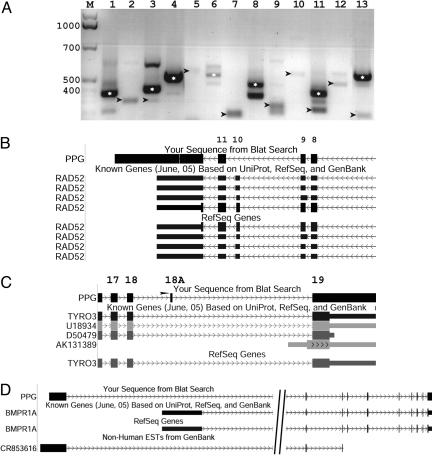Fig. 3.
Experimental verification of selected variants that were predicted by using PPGs. (A) RT-PCR was carried out by using RNA pool from 16 different tissue types (see Methods). White point indicate the major splice form (“wild type”) for each gene (wild type does not exist in the gel when variant-specific primers were used); arrows indicate the validated isoforms. Lanes: M, 1-kb DNA size marker; 1, PLA2G10, variant not validated; 2, TYRO3, a unique exon (18A) validated; 3, RAD52, skipping on exon 10 validated; 4, PTPN11, variant not validated; 5, HAVCR1, unique promoter validated; 6, MMRN2, variant not validated; 7, RYK, skipping on exon 5 validated; 8, IMP-2, variant not validated; 9, PIP5K1A/PSMD4, transcription-mediated gene fusion validated; 10, ESRRA, 5′ extension of alternative first exon validated; 11, ENDOGL1, a unique combination of splicing events (3′ truncation of exon 2 and skipping on the following exon) validated; 12, BMPR1A, alternative promoter validated; 13, IPO7, skipping exons 21 and 22 validated [this PPG was not found in the original PPG database of Zhang et al. (22), and is presented here to demonstrate that additional variants exist in other genomic PPGs]. Two additional genes (CTAGE5 and TARDBP), for which no variant was detected, are not included in this figure. (B–D) Detailed examples of three transcript isoforms predicted by PPGs and experimentally validated. Shown are snapshots from the University of California, Santa Cruz, genome browser (http://genome.ucsc.edu/cgi-bin/hgGateway; hg17). Boxes depict exons, and thin arrowed lines are introns. The “Blat search” track shows the alignment of the PPG to its gene of origin. Index numbers of exons are marked above the track. (B) Skipping on exon 10 in human RAD52. PPG sequence aligns to the RAD52 locus at 84.3% identity. (C) New exon (marked by arrowhead) in the TYRO3 gene. PPG sequence aligns to the TYRO3 locus at 90.3% identity. (D) PPG showing promoter (alternative first exon) in the gene BMP1RA (PPG is 98% identical with original gene). An EST (CR853616) from Pongo pygmaeus (orangutan) indicates the same variant when aligned to the human genome.

